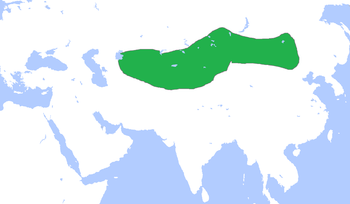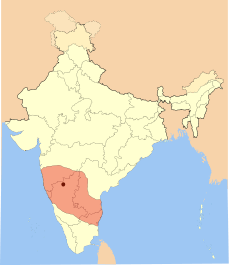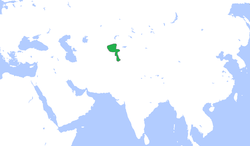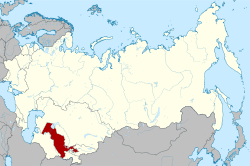List of Turkic dynasties and countries
÷÷The following is a list of dynasties and states, both current and past, of Turkic origins or which are Turkic-speaking, or both. The Turkic peoples are a collection of ethnic groups that live in northern, eastern, central, and western Asia, northwestern China, and parts of eastern Europe.
World map with present-day independent recognized Turkic countries highlighted in red
Current states
Current independent states
| Name | Years | |
 Turkey Turkey |
1923 |
86.2% Turkish, Demographics of Turkey. |
 Azerbaijan Azerbaijan |
1991 |
91.6% Azerbaijani, 0.29% Tatar.[1] |
 Kazakhstan Kazakhstan |
1991 |
63.1% Kazakh, 2.9% Uzbek, 1.4% Uyghur, 1.3% Tatar, 0.6% Turkish, 0.5% Azerbaijani, 0.1% Kyrgyz.[2] |
 Kyrgyzstan Kyrgyzstan |
1991 |
70.9% Kyrgyz, 14.3% Uzbeks, 0.9% Uyghur, 0.7% Turkish, 0.6% Kazakh, 0.6% Tatar, 0.3% Azerbaijani.[3] |
 Turkmenistan Turkmenistan |
1991 |
75.6% Turkmen, 9.2% Uzbek, 2.0% Kazakh, 1.1% Turkish 0.7% Tatar[4] |
 Uzbekistan Uzbekistan |
1991 |
71.4% Uzbek, 4.1% Kazakh, 2.4% Tatar, 2.1% Karakalpak, 1% Crimean Tatar, 0.8% Kyrgyz, 0.6% Turkmen, 0.5% Turkish, 0.2% Azerbaijani, 0.2% Uyghur, 0.2% Bashkir.[5] |
|
De-facto state
This republic is recognized only by Turkey and by the Autonomous Republic of Nakhichevan in Azerbaijan.
Federal subjects of Russia
- Turkic nations where Turkic people are a majority
- Turkic nations where Turkic people are a minority
Autonomous regions
Turkic confederations, dynasties, and states
Tribal confederations
Turkic dynasties and states
| Name |
Years |
Capital |
map |
 Turkic Khaganate Turkic Khaganate |
552–ca. 580
682-744 |
Ordu Baliq |
 |
| Xueyantuo |
628–646 |
|
|
| Kangar union |
659–750 |
located in Ulutau mountains |
 |
| Türgesh |
699–766 |
Balasagun |
 |
| Kimeks |
743–1220 |
Khagan-Kimek Imekia |
 |
 Uyghur Khaganate Uyghur Khaganate |
744–848 |
Ordu Baliq |
 |
| Oghuz Yabgu State |
750–1055 |
Yangikent |
 |
| Karluk Yabgu State |
756-940 |
Suyab later Balasagun |
 |
| Kara-Khanid Khanate |
840–1212 |
Balasagun, Kashgar, Samarkand |
 |
| Gansu Uyghur Kingdom |
848–1036 |
Zhangye |
 |
| Kingdom of Qocho |
856-1335 |
Gaochang, Beshbalik |
 |
| Pechenegs |
860–1091 |
|
 |
 Cumania[11][12] Cumania[11][12] |
900–1220 |
|
_en.png) |
| Anatolian Beyliks |
11th–16th century |
Many such as Karaman, Sinop, Adana, Alanya, Kahramanmaraş. |
90px |
| Ahmadilis |
1122–1209 |
Maragha |
 |
| Eldiguzids |
ca.1135–1225 |
Nakhchivan (city) and Hamadan |
 |
| Salghurids |
1148–1282 |
Fars Province |
 |
 Ottoman Empire Ottoman Empire |
1299-1923 |
Söğüt 1299–1335, Bursa 1335–1413, Adrianople 1413–1453, Constantinople 1453–1922 |
 |
| Sufids |
1361–1379 |
|
|
|
Europe
Middle East
Indian subcontinent
Sinicized Turkic dynasties
The Shatuo Turks founded several sinicized dynasties in northern China during the Five Dynasties and Ten Kingdoms period. The official language of these dynasties was Chinese and they used Chinese titles and names.
Turko-Persian states
The Turko-Persian tradition was an Islamic tradition of the interpretation of literary forms, practiced and patronized by Turkic rulers and speakers. Many Turko-Persian states were founded in modern-day Eastern Turkey, Iran, Iraq, Turkmenistan and Uzbekistan.[16]
| Name |
|
Years |
Capital |
Map |
| Ghaznavid Empire |
Ruled by a thoroughly Persianized family of Turkic mamluk origin[17][18] |
962–1186 |
Ghazna 977–1163, Lahore 1163–1186 |
.PNG) |
 Great Seljuk Empire Great Seljuk Empire |
Ruled by a clan[19] of originally Oghuz Turkic descent[17][20][21][22] |
1037–1194 |
Nishapur 1037–1043, Rey, Iran 1043–1051, Isfahan 1051–1118, Hamadan Western capital 1118–1194, Merv Eastern capital (1118–1153) |
 |
| Seljuk Sultanate of Rûm |
|
1077–1307 |
İznik , Iconium (Konya) |
 |
| Khwarazmian dynasty |
Ruled by a family of Turkic mamluk origin.[23] |
1077–1231/1256 |
Gurganj 1077–1212, Samarkand 1212–1220, Ghazna 1220–1221, Tabriz 1225–1231 |
.PNG) |
 Kara Koyunlu Kara Koyunlu |
|
1375–1468 |
Tabriz |
 |
 Aq Qoyunlu Aq Qoyunlu |
|
1378–1501 |
Diyarbakır : 1453 – 1471, Tabriz :1468 – January 6, 1478 |
 |
|
Turco-Mongol states
Turco-Mongol is a term describing the synthesis of Mongol and Turkic cultures by several states of Mongol origin throughout Eurasia. These states adopted Turkic languages, either among the populace or among the elite, and converted to Islam, but retained Mongol political and legal institutions. Two of these states founded by the Timurid dynasty, specifically the Timurid Empire and Mughal Empire were influenced by the Persian and Indian cultures.
Iranian dynasties of Turkic origins
Former Republics
Soviet Republics
Autonomous Soviet Republics
Autonomous oblasts of the Soviet Union
See also
Notes
- ↑ Demographics of Azerbaijan.
- ↑ Demographics of Kazakhstan.
- ↑ Demographics of Kyrgyzstan
- ↑ Demographics of Turkmenistan
- ↑ Demographics of Uzbekistan
- ↑ Recognized only by Turkey and the Autonomous Republic of Nakhichevan in | Azerbaijan, see Cyprus dispute.
- ↑ Gagauzia
- ↑ Xinjiang
- ↑ Veronika Veit, ed. (2007). The role of women in the Altaic world: Permanent International Altaistic Conference, 44th meeting, Walberberg, 26-31 August 2001. Volume 152 of Asiatische Forschungen (illustrated ed.). Otto Harrassowitz Verlag. p. 61. ISBN 3447055375. Retrieved 8 February 2012.
- ↑ Michael Robert Drompp (2005). Tang China and the collapse of the Uighur Empire: a documentary history. Volume 13 of Brill's Inner Asian library (illustrated ed.). BRILL. p. 126. ISBN 9004141294. Retrieved 8 February 2012.
- ↑ Encyclopedia of European peoples, Vol.1, Ed. Carl Waldman, Catherine Mason, (Infobase Publishing Inc., 2006), 475; "The Kipchaks were a loose tribal confederation of Turkics...".
- ↑ Vásáry, István, Cumans and Tatars: Oriental military in the pre-Ottoman Balkans, 1185–1365, (Cambridge University Press, 2005), 6; "..two Turkic confederacies, the Kipchaks and the Cumans, had merged by the twelfth century.".
- ↑ Peter Sarris (2011). Empires of Faith: The Fall of Rome to the Rise of Islam, 500-700. p. 308.
- ↑ Wudai Shi, ch. 75. Considering the father was originally called Nieliji without a surname, the fact that his patrilineal ancestors all had Chinese names here indicates that these names were probably all created posthumously after Shi Jingtang became a "Chinese" emperor. Shi Jingtang actually claimed to be a descendant of Chinese historical figures Shi Que and Shi Fen, and insisted that his ancestors went westwards towards non-Han Chinese area during the political chaos at the end of the Han Dynasty in early 3rd century.
- 1 2 According to Old History of the Five Dynasties, vol. 99, and New History of the Five Dynasties, vol. 10. Liu Zhiyuan was of Shatuo origin. According to Wudai Huiyao, vol. 1 Liu Zhiyuan's great-great-grandfather Liu Tuan (劉湍) (titled as Emperor Mingyuan posthumously, granted the temple name of Wenzu) descended from Liu Bing (劉昞), Prince of Huaiyang, a son of Emperor Ming of Han
- ↑ Lewis, Bernard. "Istanbul and the Civilization of the Ottoman Empire", p29. Published 1963, University of Oklahoma Press. ISBN 0-8061-1060-0.
- 1 2 M.A. Amir-Moezzi, "Shahrbanu", Encyclopaedia Iranica, Online Edition, (LINK): "... here one might bear in mind that non-Persian dynasties such as the Ghaznavids, Saljuqs and Ilkhanids were rapidly to adopt the Persian language and have their origins traced back to the ancient kings of Persia rather than to Turkish heroes or Muslim saints ..."
- ↑ Muhammad Qāsim Hindū Šāh Astarābādī Firištah, "History Of The Mohamedan Power In India", Chapter I, "Sultān Mahmūd-e Ghaznavī", p.27: "... "Sabuktegin, the son of Jūkān, the son of Kuzil-Hukum, the son of Kuzil-Arslan, the son of Fīrūz, the son of Yezdijird, king of Persia. ..."
- ↑ Jonathan Dewald, "Europe 1450 to 1789: Encyclopedia of the Early Modern World", Charles Scribner's Sons, 2004, p. 24
- ↑ K.A. Luther, "Alp Arslān" in Encyclopaedia Iranica, Online Edition, (LINK): "... Saljuq activity must always be viewed both in terms of the wishes of the sultan and his Khorasanian, Sunni advisors, especially Nezām-al-molk ..."
- ↑ Encyclopaedia Britannica, "Seljuq", Online Edition, (LINK): "... Because the Turkish Seljuqs had no Islamic tradition or strong literary heritage of their own, they adopted the cultural language of their Persian instructors in Islam. Literary Persian thus spread to the whole of Iran, and the Arabic language disappeared in that country except in works of religious scholarship ..."
- ↑ O.Özgündenli, "Persian Manuscripts in Ottoman and Modern Turkish Libraries", Encyclopaedia Iranica, Online Edition, (LINK)
- ↑ M. Ismail Marcinkowski, Persian Historiography and Geography: Bertold Spuler on Major Works Produced in Iran, the Caucasus, Central Asia, India and Early Ottoman Turkey, with a foreword by Professor Clifford Edmund Bosworth, member of the British Academy, Singapore: Pustaka Nasional, 2003, ISBN 9971-77-488-7.
- ↑ Thackston 1996
- ↑ Findley 2005
- ↑ Saunders 1970, p.177
- ↑ "The Islamic World to 1600: The Mongol Invasions (The Tamarind Empire)". Ucalgary.ca. Retrieved 2011-07-06. ; "The Islamic World to 1600: Rise of the Great Islamic Empires (The Mughal Empire)". Ucalgary.ca. Retrieved 2011-07-06.
- ↑ Helen Chapin Metz. Iran, a Country study. 1989. University of Michigan, p. 313.
- ↑ Emory C. Bogle. Islam: Origin and Belief. University of Texas Press. 1989, p. 145.
- ↑ Stanford Jay Shaw. History of the Ottoman Empire. Cambridge University Press. 1977, p. 77.
- ↑ Andrew J. Newman, Safavid Iran: Rebirth of a Persian Empire, IB Tauris (March 30, 2006).
- ↑ http://www.iranicaonline.org/articles/afsharids-dynasty
- ↑ Abbas Amanat, The Pivot of the Universe: Nasir Al-Din Shah Qajar and the Iranian Monarchy, 1831–1896, I.B.Tauris, pp 2–3
- ↑ Richard N. Frye and Lewis V. Thomas. The United States and Turkey and Iran, Harvard University Press, 1951, p. 217
Further reading
- Finkel, Caroline, "Osman's Dream, History of the Ottoman Empire 1300-1923", 2005, John Murray ISBN 0-465-02396-7
- Findley, C.V., The Turks in World History, 2005, Oxford University Press. ISBN 0-19-517726-6
- Forbes Manz, B., The Rise and Rule of Tamerlane, 2002, Cambridge University Press. ISBN 0-521-63384-2
- Hupchick, D.P., The Balkans: From Constantinople to Communism, 2002, Palgrave Macmillan. ISBN 1-4039-6417-3
- Lewis, Bernard. "Istanbul and the Civilization of the Ottoman Empire", 1963, University of Oklahoma Press. ISBN 0-8061-1060-0.
- Saunders, J.J., The History of the Mongol Conquests, 2001, Routledge & Kegan Ltd. ISBN 978-0-8122-1766-7
- Thackston, W.M., The Baburnama: Memoirs of Babur, Prince and Emperor, 2002, Modern Library. ISBN 978-0-375-76137-9
- Vásáry, I., Cumans and Tatars: Oriental Military in the Pre-Ottoman Balkans, 1185–1365, 2005, Cambridge University Press. ISBN 978-0-521-83756-9
- Veronika Veit, ed. (2007). The role of women in the Altaic world: Permanent International Altaistic Conference, 44th meeting, Walberberg, 26-31 August 2001. Volume 152 of Asiatische Forschungen (illustrated ed.). Otto Harrassowitz Verlag. ISBN 3447055375. Retrieved 8 February 2012.













 Cumania[11][12]
Cumania[11][12]_en.png)




























.png)






























.svg.png)

.svg.png)



